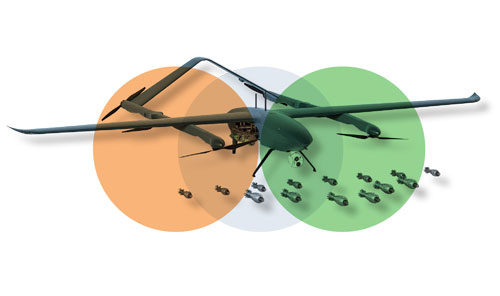INDIAN ARMED FORCES CHIEFS ON OUR RELENTLESS AND FOCUSED PUBLISHING EFFORTS

The insightful articles, inspiring narrations and analytical perspectives presented by the Editorial Team, establish an alluring connect with the reader. My compliments and best wishes to SP Guide Publications.

"Over the past 60 years, the growth of SP Guide Publications has mirrored the rising stature of Indian Navy. Its well-researched and informative magazines on Defence and Aerospace sector have served to shape an educated opinion of our military personnel, policy makers and the public alike. I wish SP's Publication team continued success, fair winds and following seas in all future endeavour!"

Since, its inception in 1964, SP Guide Publications has consistently demonstrated commitment to high-quality journalism in the aerospace and defence sectors, earning a well-deserved reputation as Asia's largest media house in this domain. I wish SP Guide Publications continued success in its pursuit of excellence.
Develop Anti-Drone Technology
In light of the long and hot border with China, which is a world leader in drone manufacturing, India needs to do a lot more to enhance its anti-drone capabilities

Modern warfare is evolving with modern technology. One such technology that had made a huge difference in today’s battlefields and has changed the dynamics on battlegrounds is the effective use of drones for a variety of purposes, not just for ISR but in combat roles as well where the basic method is to equip drones with gravity bombs or turn the drone into a miniature kamikaze-like weapon. Since they are relatively small, such drones are able to sneak up on unsuspecting targets during day and night and hit them when they might be most vulnerable. Small, relatively cheap, and easy to use, these drones are effective against any target.
Recent conflicts, such as the Russian invasion of Ukraine and the days-old fighting between Israel and Hamas, show the growing importance of drones in war, especially the smaller ones which are relatively cheaper to procure and easier to handle. Even in earlier conflicts in Central Asia and the Middle East like the Nagorno-Karabakh war, the Yemen war, the long drawn war in Syria or the Afghanistan war, drones were used very effectively. The threat from drones is likely to increase as technical advancements such as artificial intelligence and machine learning increase their capabilities and as the costs of such systems come down.
Meanwhile, China has emerged as the unrivalled global leader in drone manufacturing, showcasing remarkable prowess across a spectrum of drone technologies, from combat drones to sophisticated drone swarms. China’s pioneering strides in drone swarm technology include the capacity to deploy hundreds or even thousands of drones concurrently, serving various purposes like surveillance, communication relay, and precision strikes. With substantial investments in research and development, both private Chinese companies and the People’s Liberation Army (PLA) have propelled China to the forefront of the drone industry.
China’s arsenal encompasses an extensive array of combat drones, designed for roles ranging from reconnaissance to precision strike missions and electronic warfare and have found export market into various countries across the globe, particularly the Middle East and Africa, where they have been used in conflict zones. Pakistan also is a significant recipient of Chinese drone technology and has effectively employed them in operations against militant groups in border regions.
The export of Chinese combat drones and drones with military applications is likely to continue to grow in the coming years. Chinese drone manufacturers are becoming increasingly sophisticated and capable, and the global demand for combat drones and drones with military applications is growing. Additionally, the Chinese government is expected to continue to support the export of combat drones and drones with military applications, as it sees this as a way to advance its foreign policy goals.
These facts carry profound implications for the evolving landscape of modern warfare and surveillance capabilities, especially India which shares a large and hotly contested border with China. India’s anti-drone capabilities have been growing in recent years, but the country still has a long way to go to match the capabilities of China, the world leader in drone manufacturing. India has a number of indigenous anti-drone systems under development, but most of these are still in the early stages of testing and evaluation. The Indian armed forces have also procured some anti-drone systems from foreign suppliers, but the numbers are still relatively small.
One of the key challenges facing India is the development of a comprehensive anti-drone strategy. This strategy should include measures for detection, tracking, identification, and neutralisation of drones. It should also include measures to protect critical infrastructure from drone attacks.
Another challenge is the development of effective counter-drone technologies. There are two main ways to down a drone – kinetically and electronically. The first means shooting down a drone with bullets, rockets, or similar. The second means jamming or interrupting the signal between the drone and its operator(s). A more advanced version of this approach is to hack the drone and take over its command. These technologies should be able to deal with a wide range of drones, from small commercial drones to large military drones. They should also be able to deal with drones that are equipped with advanced technologies, such as swarming and electronic warfare.
India needs to develop indigenous anti-drone technologies to reduce its dependence on foreign imports with a focus on developing new age anti-drone technologies, such as directed energy weapons and counter-swarm technologies. Also, India needs to invest more in research and development of anti-drone technologies. This will help the country to develop indigenous systems that are tailored to its specific needs and better protect itself from drone threats, especially from China.





